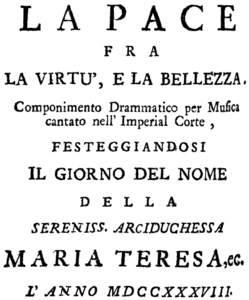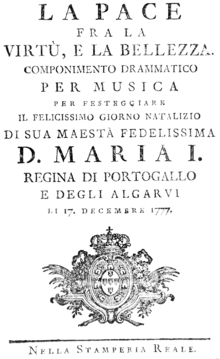La pace from la virtu e la bellezza
| Work data | |
|---|---|
| Title: | La pace from la virtu e la bellezza |

Title page of the libretto from 1738 |
|
| Shape: | Azione teatrale |
| Original language: | Italian |
| Music: | First setting by Luca Antonio Predieri |
| Libretto : | Pietro Metastasio |
| Premiere: | October 15, 1738 |
| Place of premiere: | Vienna |
| people | |
La pace fra la virtù e la bellezza (German: "Peace between virtue and beauty") is a libretto for an Azione teatrale in one act by Pietro Metastasio . The first setting by Luca Antonio Predieri was performed on the name day of Archduchess Maria Theresa on October 15, 1738 in the great anteroom of the imperial residence in Vienna.
action
The plot is a continuation of the myth of the judgment of Paris . Paris should decide which of the three goddesses Aphrodite (Venus), Athene (Pallas) or Hera was the most beautiful. He chose Aphrodite and gave her a golden apple as a prize.
At the beginning, Cupid asks his mother Venus why she is in a bad mood. It is Theresa's name day (Archduchess Maria Theresa ), and Jupiter gave her the task of conveying the good wishes of the powers of fate to her. Venus explains that Pallas, who has been hostile since Paris' decision, is contesting this task and is supported in it by many other gods. Jupiter refuses to choose between his two daughters and leaves the decision to two of these chosen arbitrators. Pallas is represented by Apollon, and Venus by Mars.
Pallas, Apollo, Mars and other gods come to end the argument. However, Venus would like to defend her fame and Pallas would like to take revenge for the injustice committed. When Cupid stands up for his mother, Pallas insults him. She demands that he be removed because he will confuse the judge and start new arguments. However, the gods allow him to remain a mute bystander, and Cupid promises to abide by it.
Because Jupiter first commissioned Venus, she is also the first to present her request. However, compared to the eloquent and warlike Pallas, she feels disadvantaged and asks for the support of the other gods. She fought for her honor with great effort. Teresa's beauties are the result of their hard work. You can see for yourself if you go to the Ister and watch Teresa there. Palla's response, confirming Teresa's beauty, is interrupted by Cupid. He claims to have mistaken Teresa for his mother several times because of her beauty. He is reprimanded by Pallas and Apollon for his interference. Pallas now declares that he also obtained many of Teresa's gifts, namely her ingenious nature, her gift for languages, her artistic talents, her extensive knowledge of geography, astronomy, history and law and all of her virtues.
Apollo explains that the choice is difficult for him. Both have different weapons, but the same powers of persuasion. Mars is also unsafe. It is still unclear whether the world honors more beauty or virtue. Venus and Pallas reaffirm at length the value of their respective gifts. Their argument eventually leads to a duet about the positive or negative nature of love.
Apollo and Mars still can't decide which one of them to use. The only solution is to make the two friends, just as both gifts are combined in Teresa. Pallas and Venus let themselves be convinced of this and fall into sisterly arms. Cupid can no longer be silent. He expects a lot from this alliance. But there is still an unresolved issue, namely the apple that Venus received from Paris. Since Teresa is undoubtedly much more beautiful than Venus, this prize is due to her and he is ready to hand it over to her. After Venus and Pallas have given their consent, Cupid sings about his own wisdom. Finally, Venus asks the gods to come along to honor Teresa. In her recitative and her last aria, she wishes her numerous descendants as a parable. In his last objection, Amor declares that he has already found a place of his own in Teresa's beautiful eyes - an allusion to Maria Theresa's love for her husband Franz von Lothringen . A hopeful final chorus ends the work.
history
La pace fra la virtù e la bellezza resembles its predecessor Il Parnaso accusato e difeso in some respects. In both cases there are five characters and a scenic plot is completely absent. The starting point of both works is the occasion of the court celebration. While there was an aesthetic and moral background in Il Parnaso accusato e difeso , La pace fra la virtù e la bellezza is limited to the praise of the beauty and virtue of Maria Theresa. The only stimulation is the repeated interference of Cupid. Such a direct homage is atypical for Metastasio's work. One reason could be that it is the first text he wrote in honor of the Archduchess, whom he admired and who previously only participated as an interpreter in works dedicated to her parents. In view of the tense political situation towards the end of the War of the Polish Succession and the problems with the implementation of the Pragmatic Sanction , he may have wanted to point out that he considered Maria Theresa worthy to succeed her father on the Austrian imperial throne - which was followed by the choice of words for the final choir suggests ("Questo giorno che tanto s'onora, / È l'aurora d'un dì più seren" - "This so honored day is the dawn of an even brighter day").
Ludwig van Beethoven used the text of the duet by Venus and Pallas "Odi l'aura che dolce sospira" as the basis of his duet Lebens-Genuss , Op. 82 No. 5.
Settings
The following composers set this libretto to music:
| year | composer | premiere | Performance location | Remarks |
|---|---|---|---|---|
| 1738 | Luca Antonio Predieri | October 15, 1738, large anteroom of the imperial residence | Vienna | “Festa di camera” on the name day of Archduchess Maria Theresa ; also in Braunschweig in 1751 as "componimento drammatico" for the birthday of Philippine Charlotte von Braunschweig-Lüneburg |
| 1739 | Antonio Bioni | October 22, 1739? | Vienna | “Serenata”, dedicated to Maria Theresia, probably not listed |
| 1746 | Andrea Adolfati | January 1, 1746, court theater | Modena | “Divertimento da camera”; Libretto edited by Leporati |
| 1766 | Baldassare Galuppi | June 28, 1766 | St. Petersburg | on the anniversary of the accession of Tsarina Catherine II. |
| 1777 | Davide Perez | December 17, 1777 | Lisbon | “Componimento drammatico” for the birthday of Queen Maria I of Portugal |
literature
- Hanna Schodterer: Pietro Antonio Metastasios Azione teatrale, La pace fra la virtù e la bellezza in settings for the Viennese court by Luca Antonio Predieri and Antonio Bioni. Diploma thesis of the University of Vienna, 2011 ( online, PDF , with working translation of the libretto into German).
Web links
Digital copies
- ^ Libretto (Italian) of the Serenata by Luca Antonio Predieri, Vienna 1738. In: Opere drammatiche, Volume Quarto , Venice 1747, as a digitized version on Google Books .
- ^ Libretto (Italian) of the opera by David Perez, Lisbon 1777. Digitized in the Corago information system of the University of Bologna .
Individual evidence
- ^ A b Don Neville: Metastasio [Trapassi], Pietro (Antonio Domenico Bonaventura). In: Grove Music Online (English; subscription required).
- ↑ Metastasio, Pietro in Die Musik in Geschichte und Gegenwart , p. 50861 ff (cf. MGG vol. 9, p. 229 ff.) Bärenreiter-Verlag 1986 ( digital library volume 60).
- ↑ a b Jacques Joly: Les fêtes théâtrales de Métastase à la cour de Vienne, 1731-1767. Pu Blaise Pascal, 1978, ISBN 978-2845160194 , p. 204 ff. ( Online at Google Books)
- ↑ Supplement to CD Beethoven - Lieder und Gesänge , SignumClassics, 2008 p. 8 (PDF) ( Memento from April 2, 2015 in the Internet Archive )
- ↑ La pace fra la virtù e la bellezza (Luca Antonio Predieri) in the Corago information system of the University of Bologna , accessed on March 16, 2015.
- ^ List of the stage works by Antonio Bioni based on the MGG at Operone, accessed on September 29, 2014.
- ^ Claudia Michels: Opera repertoire in Vienna around 1740. Approaches to an interface. In: Elisabeth Fritz-Hilscher (Ed.): In the service of a state idea. Arts and artists at the Viennese court around 1740. Böhlau Verlag Vienna Cologne Weimar, 2013, ISBN 978-3-205-78927-7 , p. 149 ( online, PDF )
- ↑ La pace fra la virtù e la bellezza (Andrea Adolfati) in the Corago information system of the University of Bologna , accessed on March 16, 2015.
- ↑ Schodterer, p. 64
- ^ Galuppi, Baldassarre, detto il Buranello. In: Dizionario Biografico - Treccani , accessed March 16, 2015.
- ↑ Библиографическая база данных (Bibliographical Database) on rasl.ru , accessed on March 16, 2015.
- ↑ La pace fra la virtù e la bellezza (David Perez) in the Corago information system of the University of Bologna , accessed on March 16, 2015.
